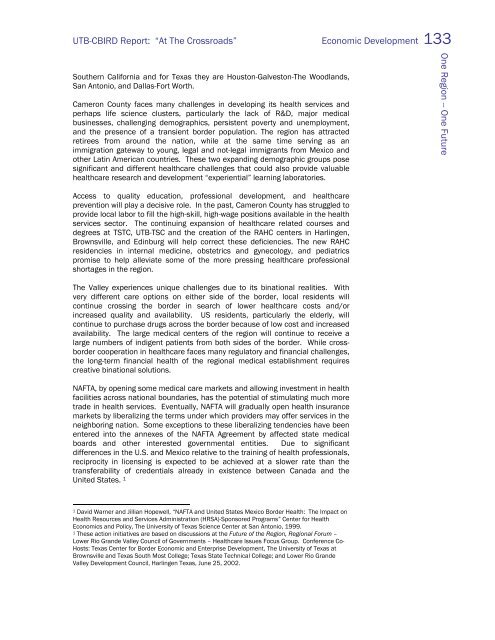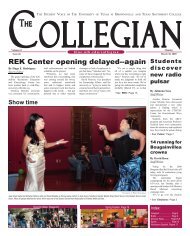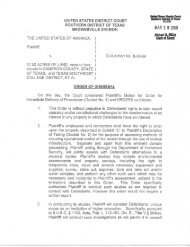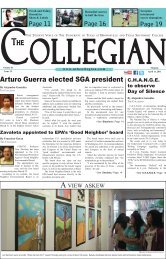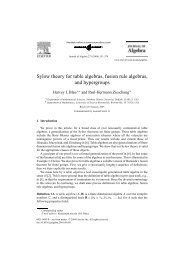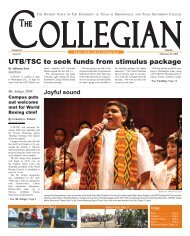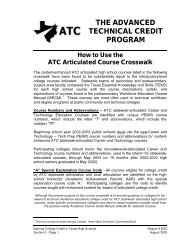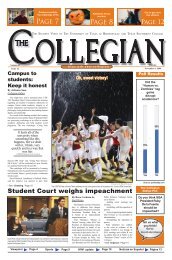cameron county/matamoros - blue - The University of Texas at ...
cameron county/matamoros - blue - The University of Texas at ...
cameron county/matamoros - blue - The University of Texas at ...
Create successful ePaper yourself
Turn your PDF publications into a flip-book with our unique Google optimized e-Paper software.
UTB-CBIRD Report: “At <strong>The</strong> Crossroads” Economic Development 133<br />
Southern California and for <strong>Texas</strong> they are Houston-Galveston-<strong>The</strong> Woodlands,<br />
San Antonio, and Dallas-Fort Worth.<br />
Cameron County faces many challenges in developing its health services and<br />
perhaps life science clusters, particularly the lack <strong>of</strong> R&D, major medical<br />
businesses, challenging demographics, persistent poverty and unemployment,<br />
and the presence <strong>of</strong> a transient border popul<strong>at</strong>ion. <strong>The</strong> region has <strong>at</strong>tracted<br />
retirees from around the n<strong>at</strong>ion, while <strong>at</strong> the same time serving as an<br />
immigr<strong>at</strong>ion g<strong>at</strong>eway to young, legal and not-legal immigrants from Mexico and<br />
other L<strong>at</strong>in American countries. <strong>The</strong>se two expanding demographic groups pose<br />
significant and different healthcare challenges th<strong>at</strong> could also provide valuable<br />
healthcare research and development “experiential” learning labor<strong>at</strong>ories.<br />
Access to quality educ<strong>at</strong>ion, pr<strong>of</strong>essional development, and healthcare<br />
prevention will play a decisive role. In the past, Cameron County has struggled to<br />
provide local labor to fill the high-skill, high-wage positions available in the health<br />
services sector. <strong>The</strong> continuing expansion <strong>of</strong> healthcare rel<strong>at</strong>ed courses and<br />
degrees <strong>at</strong> TSTC, UTB-TSC and the cre<strong>at</strong>ion <strong>of</strong> the RAHC centers in Harlingen,<br />
Brownsville, and Edinburg will help correct these deficiencies. <strong>The</strong> new RAHC<br />
residencies in internal medicine, obstetrics and gynecology, and pedi<strong>at</strong>rics<br />
promise to help allevi<strong>at</strong>e some <strong>of</strong> the more pressing healthcare pr<strong>of</strong>essional<br />
shortages in the region.<br />
<strong>The</strong> Valley experiences unique challenges due to its bin<strong>at</strong>ional realities. With<br />
very different care options on either side <strong>of</strong> the border, local residents will<br />
continue crossing the border in search <strong>of</strong> lower healthcare costs and/or<br />
increased quality and availability. US residents, particularly the elderly, will<br />
continue to purchase drugs across the border because <strong>of</strong> low cost and increased<br />
availability. <strong>The</strong> large medical centers <strong>of</strong> the region will continue to receive a<br />
large numbers <strong>of</strong> indigent p<strong>at</strong>ients from both sides <strong>of</strong> the border. While crossborder<br />
cooper<strong>at</strong>ion in healthcare faces many regul<strong>at</strong>ory and financial challenges,<br />
the long-term financial health <strong>of</strong> the regional medical establishment requires<br />
cre<strong>at</strong>ive bin<strong>at</strong>ional solutions.<br />
NAFTA, by opening some medical care markets and allowing investment in health<br />
facilities across n<strong>at</strong>ional boundaries, has the potential <strong>of</strong> stimul<strong>at</strong>ing much more<br />
trade in health services. Eventually, NAFTA will gradually open health insurance<br />
markets by liberalizing the terms under which providers may <strong>of</strong>fer services in the<br />
neighboring n<strong>at</strong>ion. Some exceptions to these liberalizing tendencies have been<br />
entered into the annexes <strong>of</strong> the NAFTA Agreement by affected st<strong>at</strong>e medical<br />
boards and other interested governmental entities. Due to significant<br />
differences in the U.S. and Mexico rel<strong>at</strong>ive to the training <strong>of</strong> health pr<strong>of</strong>essionals,<br />
reciprocity in licensing is expected to be achieved <strong>at</strong> a slower r<strong>at</strong>e than the<br />
transferability <strong>of</strong> credentials already in existence between Canada and the<br />
United St<strong>at</strong>es. 1<br />
1 David Warner and Jillian Hopewell, “NAFTA and United St<strong>at</strong>es Mexico Border Health: <strong>The</strong> Impact on<br />
Health Resources and Services Administr<strong>at</strong>ion (HRSA)-Sponsored Programs” Center for Health<br />
Economics and Policy, <strong>The</strong> <strong>University</strong> <strong>of</strong> <strong>Texas</strong> Science Center <strong>at</strong> San Antonio, 1999.<br />
1 <strong>The</strong>se action initi<strong>at</strong>ives are based on discussions <strong>at</strong> the Future <strong>of</strong> the Region, Regional Forum –<br />
Lower Rio Grande Valley Council <strong>of</strong> Governments – Healthcare Issues Focus Group. Conference Co-<br />
Hosts: <strong>Texas</strong> Center for Border Economic and Enterprise Development, <strong>The</strong> <strong>University</strong> <strong>of</strong> <strong>Texas</strong> <strong>at</strong><br />
Brownsville and <strong>Texas</strong> South Most College; <strong>Texas</strong> St<strong>at</strong>e Technical College; and Lower Rio Grande<br />
Valley Development Council, Harlingen <strong>Texas</strong>, June 25, 2002.<br />
One Region -- One Future


